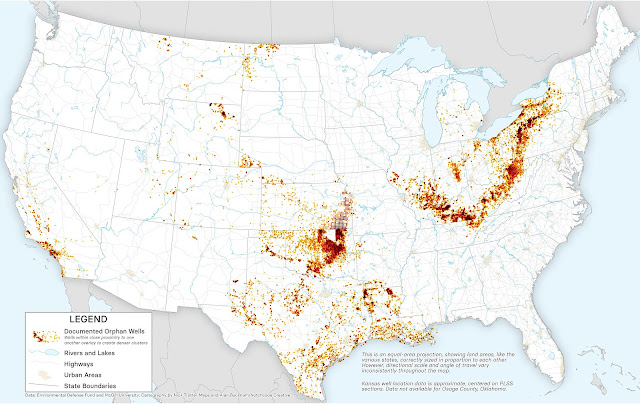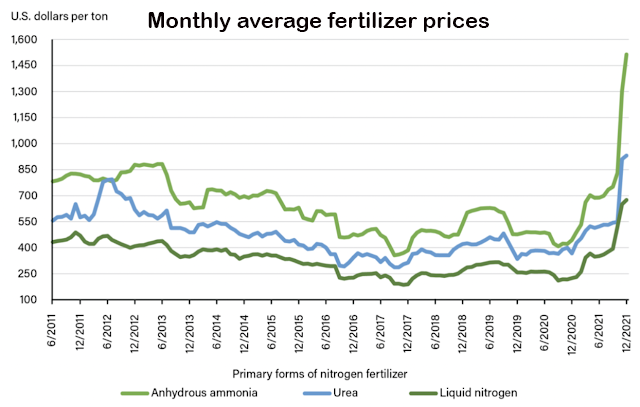The war — and efforts by the United States and its allies to stem purchases of Russian energy products — sent the price of crude oil skyrocketing. Many gasoline stations have only two or three days of product in stock, and so price gasoline at what it will cost to refill those tanks underground. This is an economic term known as “
replacement cost.”
Every $10 increase in the price of crude oil adds about 24 cents to the cost of each gallon of gasoline and is quickly reflected in what you pay at the pump. It’s not an example of price gouging. Still, the price of gasoline is nearing — or may exceed — previous
inflation-adjusted highs reached in
1918, 1981 and 2008.
Is the United States ramping up its oil production, or holding it back?
The oil business in the United States is run by private companies, not the U.S. government. It’s also a cyclical business and oil prices have been low for some time and drilling has also been low.
During the initial stages of the coronavirus pandemic, when oil prices fell sharply, to about $23 a barrel, production plummeted because it was no longer as profitable. Now, with crude oil above $100 a barrel, there is more of an incentive to ramp up U.S. production, though it is still
below the high reached in 2020 before the pandemic struck.
In February 2020, U.S. oil production reached 13.1 million barrels a day. Two years later,
in February of this year, production was about 11 percent lower — 11.6 million barrels a day.
Gasoline prices have steadily risen in the United States since April 2020, when the
weekly price dropped to as low $1.77 a gallon. It had already risen to $2.38 a gallon when Biden took office.
There’s little evidence that Biden’s policies have had any direct impact on oil production. However, the U.S. government can have an effect of shaping market perceptions that on the margins can affect prices.
As soon as he took office, Biden terminated the Keystone XL pipeline and signaled a hostility to the fossil fuel industry with a major push for clean energy, including
a pledge to cut U.S. greenhouse gas emissions by at least 50 percent of 2005 levels by 2030.
Keystone XL still would not have been built by now even if Biden had permitted it to go forward — and even if it were in place, the impact in prices would be measured in pennies. Moreover, even without Keystone XL, imports from Canada have
increased about 50 percent over the past decade. But Biden’s actions early in his tenure, some experts say, sent “yellow light” signals to the market that cost of drilling for oil might rise and so caution was warranted.
The reverse can also be true. The Trump’s administration’s opposite “green light” approach — few regulations and no restraints — led some oil drillers to invest in unprofitable wells.
Biden also issued an executive order that paused new oil and gas leases on government land, but within months a federal judge blocked it. After his first year, Biden had
outpaced Donald Trump in issuing drilling permits on public lands.
Just because a company has received a permit to drill, it has no obligation to do so. One important metric is what is known as a DUC — a drilled but uncompleted oil or gas well. In other words, production equipment has not been installed and so the well cannot yet produce hydrocarbons. The number of DUCs reached a high of 6,340 in June 2020, and as of February had dropped to 4,372,
according to EIA.
Can the U.S. truly change oil prices by encouraging more drilling and allowing pipelines?
Not really. The United States
in 2020 was the biggest oil producer in the world and also the biggest consumer, but it is just one player in a global oil market. (“Oil” includes crude oil, all other petroleum liquids, and biofuels.) Much of what happens in the market is beyond the government’s control.
In
2021, the United States slipped to third place in oil production, behind Russia and Saudi Arabia. That’s mainly because large shale companies committed to Wall Street that they would continue to limit production and return more cash to shareholders — “an effort to win back investors who fled the industry after years of poor returns,”
according to the Wall Street Journal. Scott Sheffield, chief executive of Pioneer Natural Resources, told investors in February: “$100 oil, $150 oil, we’re not going to change our growth rate.”
U.S. oil producers boosted output by more than 50 percent between 2016 and 2020, so it’s certainly possible for the United States to once again become the world’s biggest oil producer. But investors are demanding that companies do not overspend on new investments this time around.
If the United States is a top oil producer, why do we still need to import oil?
The United States actually exports more oil than it imports. In 2021,
according to the Energy Information Administration, the United States imported about 8.47 million barrels per day of petroleum, compared to exports of 8.63 million barrels per days. Crude accounts for about 35 percent of those exports. One key reason is that foreign countries use more diesel than the United States and the United States uses more gasoline.
The boom in U.S. shale oil has certainly reduced reliance on foreign oil imports, but not all crude is the same. Refiners on the Gulf Coast, for instance, have been optimized for Venezuelan crude, which has a high sulfur content. When the Trump administration put sanctions on Venezuelan petroleum, refiners
started imported Russian petroleum products because they are roughly similar. Now that Russia has been sanctioned, refiners probably will have to adjust to a cleaner type of crude.
In other words, the United States cannot be an island in the worldwide energy market. But it is more secure as a net exporter of petroleum.
Would funding more renewables help make the U.S. energy independent?
Not in the short run. Renewables replace natural gas or coal. You still need oil to drive cars and trucks and fly planes. At this point, the electric-vehicle market is not growing fast enough to make much of a difference in the current standoff with Russia. But long-run investments over time could begin to make a difference.














